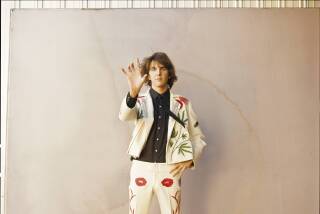Dance and Music : ‘Caught’ Becomes Parsons’ Showpiece at Royce Hall
- Share via
When the David Parsons Dance Company first appeared at Royce Hall, UCLA, three years ago, Parsons himself couldn’t perform due to injury and his signature solo, “Caught,” created a sensation for guest artist Gary Chryst.
Prowling the stage like a trapped animal, Chryst suddenly hovered high above it, lit by strobe flashes, each jump prolonged by the effect of the strobe and linked to the next so that the dancer seemed never to touch the floor.
On Friday, Parsons finally had his chance to dance “Caught” in the same theater, and he too created a sensation. But where Chryst had found a dramatic purpose in the solo’s contrasts between aerial and floor activity, Parsons made it nothing more than a showpiece.
Comparing Parsons’ range and depth in Paul Taylor’s company (1978 to 1987) with his dancing here and now, you notice the same failure of imagination. These days, what you get is only the tall, handsome, superbly muscled athlete that Taylor honed into one of the few authentic modern-dance stars of his generation. What you don’t get any more is emotional risk or even involvement, the sense of Parsons being absorbed into something greater than his own ego.
Part of the problem, of course, lies in the repertory he’s created for himself and his seven colleagues: mostly physically demanding but conceptually innocuous suites that work to death a limited number of motifs and a curiously juiceless movement vocabulary.
Indeed, the most satisfying item on the five-part program may well have been the men’s improvisation: an opportunity to watch Christopher Kirby, Alexander Kaschock and Jaime Martinez get individually personal, playful, slinky before Parsons came on with a (what-else?) splashy solo of his own.
Otherwise, the best Parsons works bypassed modern-dance values (especially the need for movement invention) and aimed at a style closer to Broadway or jazz choreography. With its parody of death-and-the-maiden dance-dramas and incessant mime jokes, “A Hairy Night on Bald Mountain” groped toward the kind of brilliant, farcical image-collage that Jerome Robbins achieved with his Mack Sennett ballet in the musical “High Button Shoes.”
Similarly, “Nascimento” headed in the direction of Alvin Ailey’s “Night Creature,” a witty, sophisticated jazz-dance showcase with lots of technical fireworks for the whole ensemble. No, Parsons never matched Ailey’s sharpness but in its own generalized way “Nascimento” gave pleasure.
That’s more than can be said for “Rise and Fall,” a dogged modern-dance etude about people who slump dejectedly and other people who absolutely insist on lifting them up. Fortunately, the Turtle Island String Quartet performed behind the dancers, giving the work a potency and daring the dancing alone couldn’t provide.
Finally, Parsons danced a new solo, “Tower,” in which an audiotape recycled the most shrill quotes from the ongoing debate about government arts funding. Increasingly oppressed by these recorded charges and countercharges, Parsons eventually left the stage--making a statement about an artist’s response to the controversy, but also ending yet another piece of Parsons choreography with no real interest or integrity of its own.
More to Read
The biggest entertainment stories
Get our big stories about Hollywood, film, television, music, arts, culture and more right in your inbox as soon as they publish.
You may occasionally receive promotional content from the Los Angeles Times.










